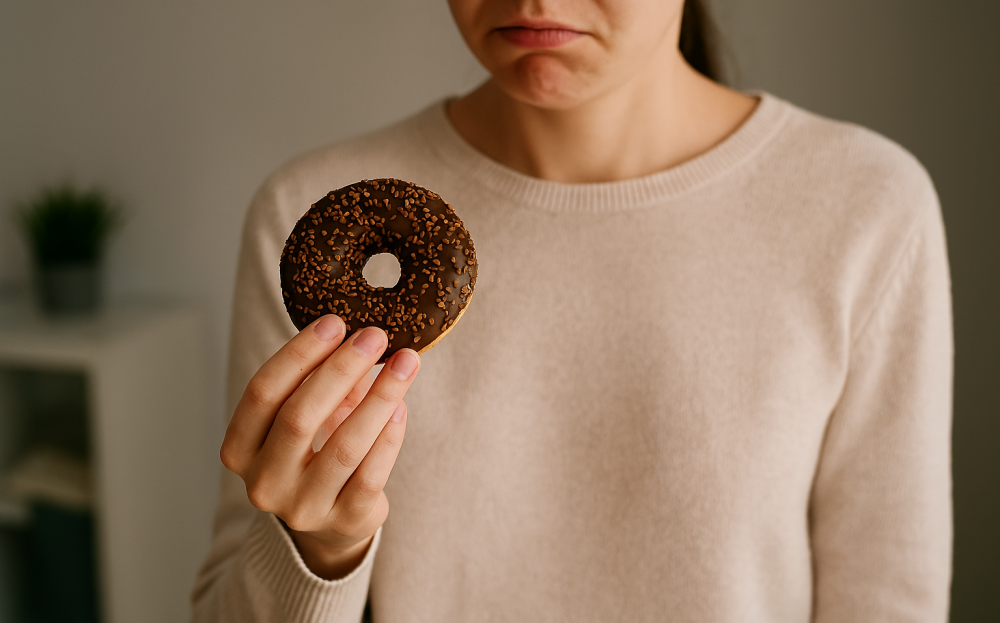Emotional eating is when someone uses food to cope with their emotions rather than satisfy hunger. It’s important to spot the difference between true hunger and emotional hunger, where you reach for that chocolate chip cookie when you’re stressed, not hungry.
Lots of us eat our feelings, whether it’s after a rough day at work or during a late-night Netflix binge. Emotions like stress, loneliness, or boredom can trigger this, pushing us to use food as a comfort or distraction. They sneak up on us, leading to that irresistible urge for comfort foods like pizza or chocolate.
Our bodies play tricks on us too. Certain emotions trigger chemical responses in our brains, leading to cravings. Ever noticed you crave sugary snacks when you’re down? That’s not a coincidence. Reinforcing connections between feelings and food can create persistent habits.
Emotional eating often links with broader mental health issues. Anxiety or depression might fuel this cycle, as food becomes a temporary source of relief. Addressing mental health is part of breaking the cycle, but it can be tough to even recognize that link in the first place.
Spotting your own emotional eating habits is a big step. Keep an eye on when and why you snack. Is it truly hunger or emotions calling the shots? Recognizing these patterns is the first move towards getting this under control. Your body’s trying to tell you something, and it’s time to listen.
Strategies for Overcoming Emotional Eating: Techniques for Healing
Why do some of us stumble more than others when it comes to emotional healing? Emotional troubles are deeply personal and rooted in individual experiences and histories. This makes healing difficult as it’s intricately tied to who we are.
Building emotional awareness goes a long way. Start recognizing and acknowledging your emotions instead of reaching for snacks. Ask yourself, ‘Am I hungry or am I bored, stressed?’ Identifying the why makes a big difference.
Mindful eating can help break the cycle. Slow down and savor your food. Really taste it, enjoy its texture. This shifts focus away from emotions and onto the eating experience itself.
Replace food with healthier coping activities. Go for a walk, call a friend, or dive into a hobby. Find something else that brings comfort and distracts you healthily.
Don’t do it alone. A support system filled with people who understand and are willing to listen can keep you grounded.
Cognitive-behavioral techniques are useful here. Challenge negative thoughts when they arise. Ask yourself if they are really true and how you can view things differently.
Journaling can be your best friend. Write down your thoughts, feelings, and patterns of eating. Seeing it on paper can provide clarity and direction.
Practice self-compassion. If you have a moment of weakness, don’t beat yourself up. Kindness toward yourself is key to progress.
Routines are great allies. A balanced routine with regular meals helps reduce the urge to stray into emotional snacking. Predictability can be comforting.
Emotional eating can be a tough cycle to break, but with the right strategies, anyone can begin to shift their habits toward healthier coping mechanisms. Here are 10 well-rounded strategies that can assist:
🧠 1. Build Emotional Awareness
- Ask yourself: “Am I truly hungry or just reacting to stress, boredom, or sadness?”
- Recognizing emotional triggers is the first step toward change.
🥢 2. Practice Mindful Eating
- Slow down and savor each bite.
- Focus on taste, texture, and the experience of eating rather than using food as distraction.
🚶♀️ 3. Replace Food with Healthy Coping Activities
- Try walking, journaling, meditating, or calling a friend.
- These alternatives can soothe emotions without relying on food.
🧘♀️ 4. Create a Balanced Routine
- Stick to regular meals and snacks to avoid impulsive emotional eating.
- Predictability in your schedule can be comforting.
📓 5. Keep a Food and Emotion Journal
- Track what you eat and how you feel before and after.
- Patterns will emerge that help you understand your emotional eating habits.
💬 6. Build a Support System
- Talk to friends, join a support group, or connect with others who understand.
- Emotional support can reduce the urge to self-soothe with food.
🧠 7. Use Cognitive-Behavioral Techniques
- Challenge negative thoughts: “Is this really true?” or “Can I see this differently?”
- Reframing your mindset helps reduce emotional triggers.
💗 8. Practice Self-Compassion
- Don’t beat yourself up over slip-ups.
- Kindness toward yourself fosters resilience and long-term change.
🧑⚕️ 9. Seek Professional Help
- Therapists or counselors can help uncover deeper emotional patterns.
- Tailored strategies can make a big difference.
🍫 10. Identify Comfort Food Cravings
- Notice which foods you reach for during emotional moments.
- Understanding these cravings helps you pause and choose differently next time.
If it feels like too much, seeking professional help is perfectly okay. Therapists or counselors can provide tailored support and strategies, diving deep into the underlying issues.
Our Website contains affiliate links this means if you click and make a purchase we may receive a small commission. “Don’t worry there is no extra cost to you. It’s a simple way you can support our mission to bring you quality content.
